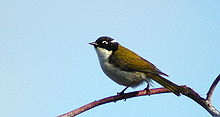- Western White-naped Honeyeater
-
Western White-naped Honeyeater 
Conservation status Scientific classification Kingdom: Animalia Phylum: Chordata Class: Aves Order: Passeriformes Family: Meliphagidae Genus: Melithreptus Species: M. chloropsis Binomial name Melithreptus chloropsis
(Gould, 1844)Synonyms - Melithreptus whitlocki Mathews, 1909
The Western White-naped Honeyeater (Melithreptus chloropsis), also known as the Swan River Honeyeater, is a passerine bird of the honeyeater family Meliphagidae native to south-western Australia.
Contents
Etymology
The Western White-naped Honeyeater was originally described by John Gould in 1844, who gave it the species name chloropsis from the Ancient Greek terms chloros "green-yellow" and opsis "eye". He called it the Swan River Honeyeater. Treated as a subspecies of the White-naped Honeyeater for many years, it was found in a 2010 study to have diverged early on from the lunatus complex. It forms a superspecies with the White-naped and Black-headed Honeyeaters.[1]
Gould called it the Swan River Honeyeater, and noted the species was known by various local indigenous names, including Jingee (lowland), Bun-geen (mountains), and Berril-berril (Swan River).[2] Gregory Mathews coined the name Melithreptus whitlocki in 1909.[3]
Taxonomy
It is a member of the genus Melithreptus with several species, of similar size and (apart from the Brown-headed Honeyeater) black-headed appearance, in the honeyeater family Meliphagidae. The next closest relative outside the genus is the much larger but similarly marked Blue-faced Honeyeater.[4] More recently, DNA analysis has shown honeyeaters to be related to the Pardalotidae (pardalotes), Acanthizidae (Australian warblers, scrubwrens, thornbills, etc.), and the Maluridae (Australian fairy-wrens) in a large Meliphagoidea superfamily.[5]
Description
A mid-sized honeyeater, it is olive green above and white below, with a black head, nape and throat and a white patch over the eye and a white crescent-shaped patch on the nape, thinner than other species. The bill is brownish-black and the eyes a dull red.[2]
Distribution and habitat
The honeyeater is found in the south-west corner of Western Australia where it ranges from Moora in the north, through the Jarrah forest belt to Broomehill, the Stirling Range and along the coast to Stokes Inlet.[6] It inhabits dry sclerophyll forests.[2]
Behaviour
Feeding
It forages in the foliage and canopy of eucalypts for insects and nectar.[2]
Breeding
The cup-shaped nests are located in the branches of trees, often hidden in foliage.[2] The nests are usually made of bark fibres, rootlets and dry grasses at a height of up to 10 m above the ground. The clutch is of two, occasionally three, pale buff eggs marked with reddish-brown and grey spots and blotches, 18 x 144 mm in size. Eggs may be found from November to January; the incubation period is 14 days, with the young remaining in the nest about another 14.[6]
Vocalisations
The honeyeater has a harsh, grating call as well as a continuously uttered, single-noted 'tsip'.[6]
References
Notes
- ^ Toon A, Hughes JM, Joseph L (2010). "Multilocus analysis of honeyeaters (Aves: Meliphagidae) highlights spatio-temporal heterogeneity in the influence of biogeographic barriers in the Australian monsoonal zone". Molecular Ecology 19 (14): 2980–94. doi:10.1111/j.1365-294X.2010.04730.x. PMID 20609078.
- ^ a b c d e Gould, John (2009). Handbook to the Birds of Australia. BiblioBazaar, LLC. pp. 570â71. ISBN 1116378205. http://books.google.com/?id=ptSnT3lwJHgC&pg=PA570&lpg=PA570&dq=%22Melithreptus+chloropsis+%22#v=onepage&q=%22Melithreptus%20chloropsis%20%22&f=false. Retrieved 19 July 2010.
- ^ Mathews, Gregory M. (1909). "Untitled". Bulletin of the British Ornithologists' Club 25: 24.
- ^ Driskell, A.C., Christidis, L (2004). "Phylogeny and evolution of the Australo-Papuan honeyeaters (Passeriformes, Meliphagidae)". Molecular Phylogenetics and Evolution 31 (3): 943–960. doi:10.1016/j.ympev.2003.10.017. PMID 15120392.
- ^ Barker, F.K., Cibois, A., Schikler, P., Feinstein, J., and Cracraft, J (2004). "Phylogeny and diversification of the largest avian radiation". Proceedings Natl. Acad. Sci. (USA) 101 (30): 11040–11045. doi:10.1073/pnas.0401892101. PMC 503738. PMID 15263073. http://www.pubmedcentral.nih.gov/articlerender.fcgi?tool=pmcentrez&artid=503738.
- ^ a b c Serventy & Whittell (1976).
Sources
- Serventy, D.L.; & Whittell, H.M. (1976). Birds of Western Australia. Perth: University of Western Australia Press. pp. 415. ISBN 0-85564-101-0.</
Categories:- IUCN Red List least concern species
- Melithreptus
- Birds of Western Australia
- Animals described in 1844
Wikimedia Foundation. 2010.

